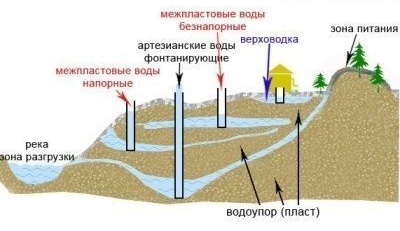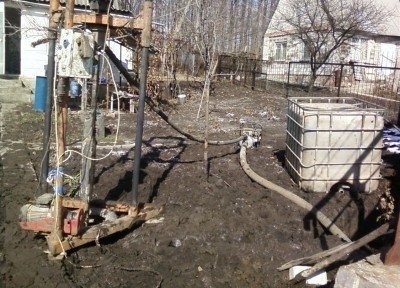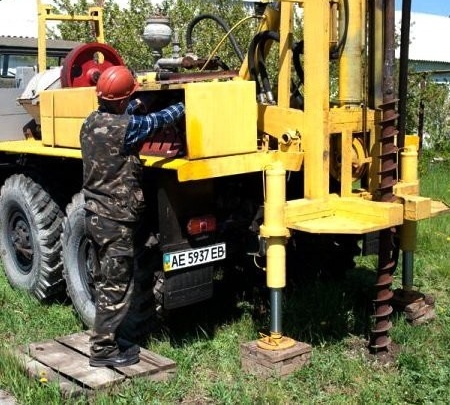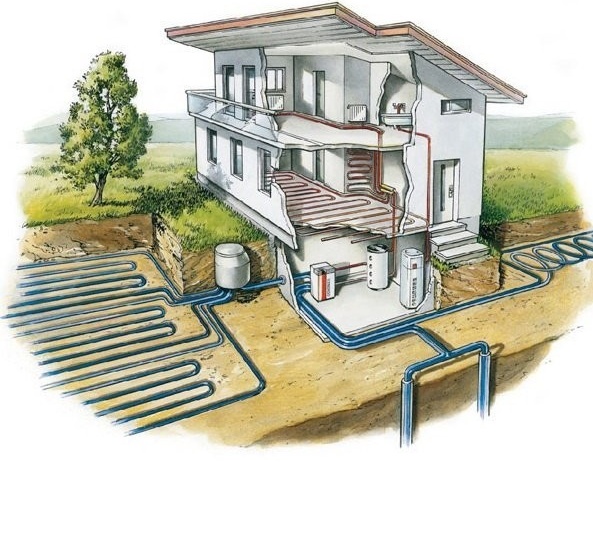DIY water well: an overview of 3 proven drilling methods
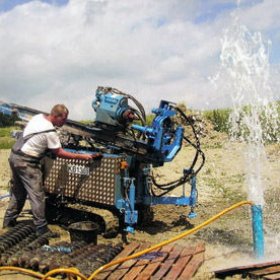
To ensure a full-fledged autonomous water supply for a country house or cottage, a well is drilled on the site, attracting specialized companies to carry out the work. Depending on the features of the geological structure of the soil, a drilling technology is selected. The use of powerful equipment allows you to punch a well in any place, while the depth of the structure can reach up to 150 meters. With a close occurrence of the aquifer, an Abyssinian well is drilled into the water with its own hands. Its depth usually does not exceed 10 meters. Before starting work, one must assess one's strengths and capabilities, since drilling a well even at a shallow depth using its own forces is a laborious task. Therefore, it is better to entrust the device of the well to water to professional drillers who will do everything in a short time and hand over the turnkey well to the customer.
Content
What types of water wells exist?
Abyssinian (tubular) well It is built with a depth of 8 to 12 meters. It differs from a normal well in that the top water does not get into drinking water, as well as dust, dirt and various foreign elements.
Before drilling an aquifer, water must be found. The 5 best search methods studied in this material:https://aquatech.tomathouse.com/en/vodosnab/kolod-skvaj/kak-najti-vodu-dlya-skvazhiny.html
Well on the sand deepened by 15-30 meters with a screw method. At the same time, the design of the well on the water looks like a pipe, at the end of which there is a section with perforation wrapped in a stainless steel metal mesh. The perforated pipe section (filter) is installed in coarse-grained sands in which there is an admixture of pebbles. The debit of the well on the sand allows you to cover the water demand in the country or in a small country house with two points of water intake. Such structures serve no more than 5 years with periodic operation and up to 15 years with constant operation. After silting a well, it is flushed or a new well is drilled nearby.
Artesian well drilled to great depths, depending on the occurrence of limestone up to 15-200 meters. Allows you to provide any amount of water in one or more country houses. Serves up to 50 years.
At the moment, a water well can be drilled in a private home ownership area using auger drilling, rotary drilling or shock-rope drilling.
A detailed overview of hydraulic drilling technology is presented in the following material:https://aquatech.tomathouse.com/en/vodosnab/kolod-skvaj/gidrobureniya-skvazhiny-svoimi-rukami.html
The difference between the listed drilling technologies from each other lies in the methods of rock destruction inside the well and options for extracting soil from the wellbore. It is clear that in each version different equipment is used that affects the quality of the well and the final cost of creating it.
Option # 1 - auger drilling
It should be noted right away that installing a well under water using auger drilling is considered to be the simplest and cheapest option. Most used small drilling rigs built on this method. The essence of the technology is the excavation using the classic Archimedean screw, called a screw. The process can be compared with drilling holes for ice fishing by winter fishing enthusiasts. Wells are drilled by the melon method, the depth of which does not reach 10 meters. It does not use water or drilling fluid to flush the structure.

There are such special easy-to-transport rigs for auger drilling. They are usually used by specialized companies.
Auger drilling is not applicable in all types of soil. Without problems, the method works in dry and relatively soft soils. It is impossible to drill with a screw quicksand and hard (rocky) rocks that may occur during drilling.
When choosing artists, attention should be paid to their experience and qualifications.
Performers should be able to not only punch holes of the required length in the soil, reaching the desired aquifer, but also protect the water carrier from ingress of water traps and sewage that seep from the surface.
Option # 2 - rotary drilling method
When drilling deep wells using the rotary method, a special drill pipe is used, in the cavity of which a rotating shaft is immersed into the well, equipped with a tip - a chisel. The load on the bit is created by the action of a hydraulic installation. This is the most common drilling method by which any depth of the well to the water is reached. To wash away the rock (soil) from the well, a drilling fluid is used, which is fed into the pipe in two ways:
- using a pump, it is pumped into the drill pipe, after which the solution with the rock flows by gravity out through the annulus (direct flushing);
- by gravity it enters the annulus, and then the solution with the rock is pumped out of the drill pipe using a pump (backwash).
Backwashing allows you to get a greater flow rate of the well, as it is possible to better open the desired aquifer. However, this technology requires the use of sophisticated equipment, which affects the increase in the cost of work. Drilling based on direct flushing is cheaper, therefore, most often, owners of private houses order this option for constructing a well for water intake.
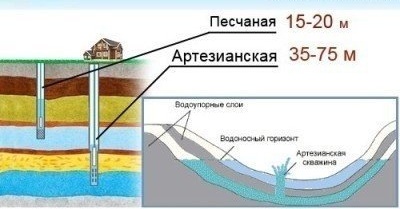
You yourself are unlikely to make an artesian well, such drilling is carried out using drilling machines by specialized companies
Option # 3 - drilling by shock-rope method
This method is the oldest, time-consuming and very slow, but with all this it is possible to get a quality well that can last up to half a century. The essence of the technology is as follows: the rock (soil) is crushed by the impact of a heavy projectile rising to a height and falling with force down. The destroyed rock is removed from the borehole using a chipper.
It is possible to make a bailer yourself after reading the following article:https://aquatech.tomathouse.com/en/vodosnab/kolod-skvaj/zhelonka-dlya-skvazhiny-svoimi-rukami.html
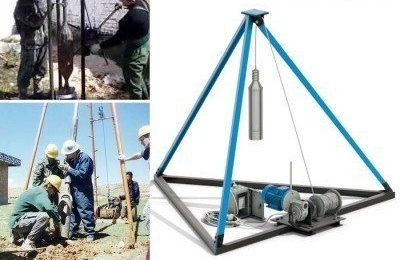
Shock-rope drilling is a fairly effective method, but is not so often used due to the high labor costs
The advantage of this drilling method is that you do not need to use water or drilling mud.Thanks to this, it is possible to open the aquifer more accurately, providing the maximum possible value of the well flow rate and the duration of its service life.
The high cost of drilling with this method is a disadvantage that the average consumer has to reckon with. The technology surpasses the rotor method in complexity. In addition, shock-rope drilling of wells with access to the second and subsequent aquifers requires isolation of the above waterbeds by using additional casing strings. Therefore, you have to spend money on the purchase of pipes of larger diameter. The volume of work performed by specialists is also increasing, which affects the budget of the structure.
Option # 4 - manual drilling (video)
Part 1:
Part 2:
Part 3:
Part 4:
Having become acquainted with the main types of wells and the methods of their construction, you can choose the most suitable option for the water supply device of your country house. Now, you know exactly how to make a well for water in such a way as to ensure the need for water in the right volumes. Usually, a well is constructed under water with its own hands on the first aquifer, which lies at a shallow depth. Artesian wells are drilled with special drilling machines, for which it is necessary to provide access to the site.
